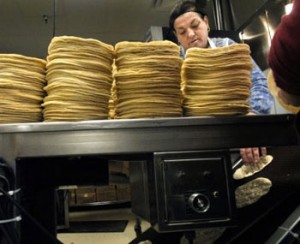 A Mexican friend was talking about the differences between the food he grew up with and American fare. There are hardly any similarities at all, but one of the things he said stuck with me: “Unless I’m served tortillas, it doesn’t seem like a meal to me.”
A Mexican friend was talking about the differences between the food he grew up with and American fare. There are hardly any similarities at all, but one of the things he said stuck with me: “Unless I’m served tortillas, it doesn’t seem like a meal to me.”
And he’s right. Tortillas are an expected, even required component of every Mexican meal. I’ve been visiting the culturally-diverse state of Oaxaca for the past two weeks. In every indigenous community throughout southern Mexico, women get up at about 4 a.m. each day to begin the long process of making enough tortillas to last the day.
They begin with a ball of corn masa, which is either patted into a round tortilla by hand or squashed flat in a hand-operated steel press. The thin tortilla is then laid on a hot, clay comal — a heavy baking tray about the size of a large pizza — and cooked until done.
In many rural towns, the tortilla serves as an edible eating utensil. Tear off a triangle of tortilla and you can use it as a spoon for beans or rice, even soup. For larger items, a piece of tortilla can be used to pinch off a bite of chicken or squash and deliver it to the mouth.
In the cities, women purchase their tortillas fresh from a nearby tortilla bakery. The masa is fed into a machine which rolls the dough flat and die-cuts perfectly round tortillas. They flop onto a steel conveyor and move through an oven, then to a waiting employee who stacks, weighs, and sells them by the kilo at the store window.
Most of the time, tortillas are merely stacked on the dinner table, wrapped inside a cloth to keep them warm. You grab one from the stack and consume it as you would bread along with the meal. Even when I’m using a knife and fork, I will usually eat three or four tortillas per meal, often rolled up and flavored a bite at a time with some of the sauces on my plate.
Day-old tortillas are fried whole to make tostadas, broken and fried to make chips, or cut into strips and cooked with a sauce and cheese to make chilaquiles. The oldest tortillas are often served to the animals.
There really is no American equivalent to the tortilla. As a kid I used to eat sliced Wonderbread with most of my meals, but it was always an add-on. In America we love variety, so we try hard not to have the same things meal after meal. Our heterogeneous culture shows up on our dinner tables with Americanized versions of meals from around the world, and the great variety of vegetables and meats available in our grocery stores assure a constantly changing dinner experience.
The only consistent element in American dining rooms is the element of surprise.
Most of our eating traditions, what few we have, center around holidays. It wouldn’t feel like Thanksgiving to me without turkey, stuffing and pumpkin pie. It wouldn’t feel like Christmas without fresh-baked cookies. Birthdays bring cake. On New Year’s we open champagne.
Last night I went out for tacos at my favorite local joint. I had tacos al pastor, which consist of a tortilla piled with some flame-grilled pork, onions, lettuce and cilantro, topped with your choice of salsa. The tortillas are miniatures, only about 3 or 4 inches across. It only takes 3 bites to devour one of these beauties, and I suspect the small size leads customers to buy more. They’re so good, I had to force myself to walk away from the table.
The more time I spend in Mexico the more I have to agree with my friend: it just doesn’t seem like a meal without tortillas.
Photo credit: Mexico: Food, Drinks and More


4
a.m., every day?!